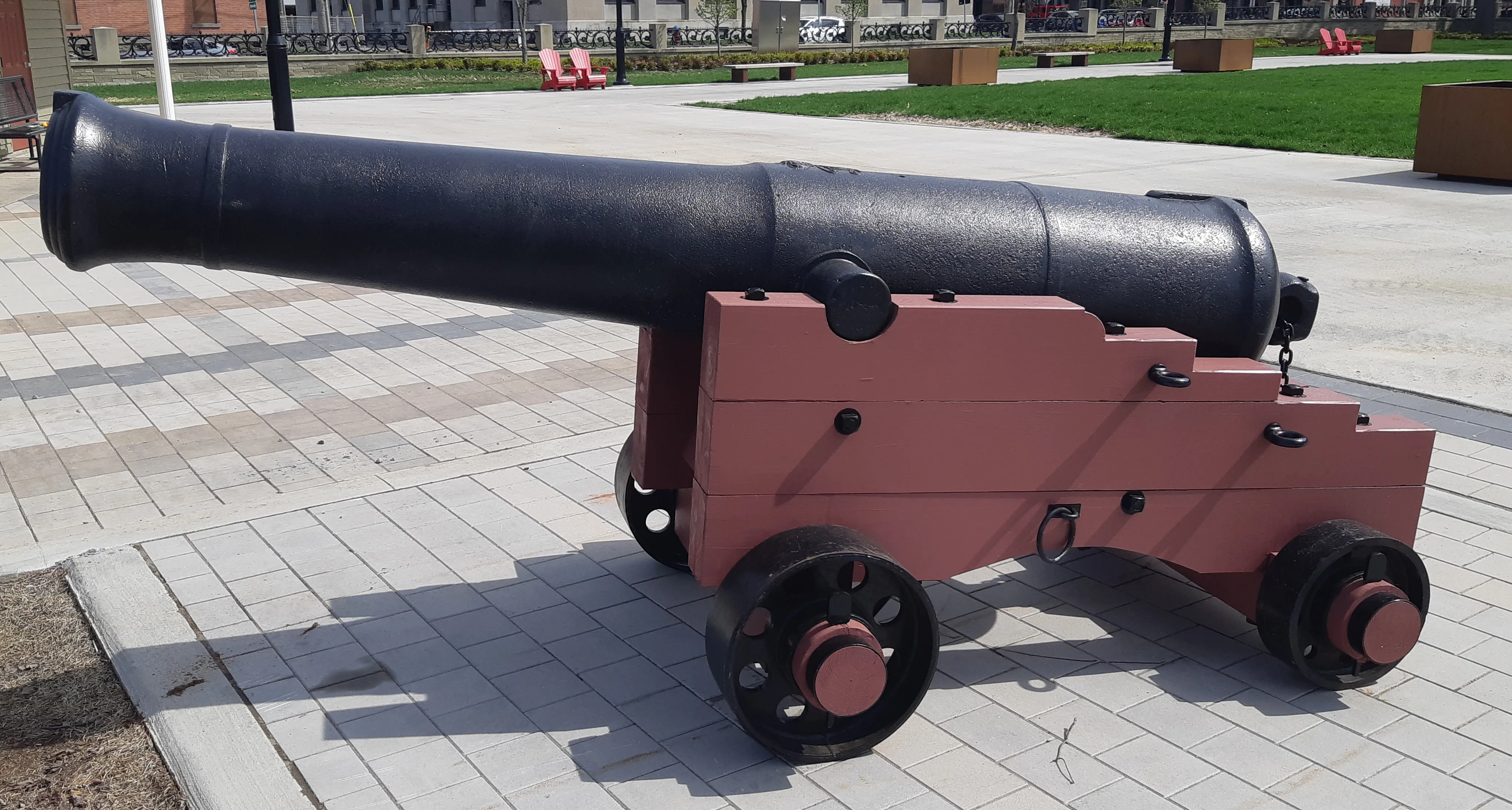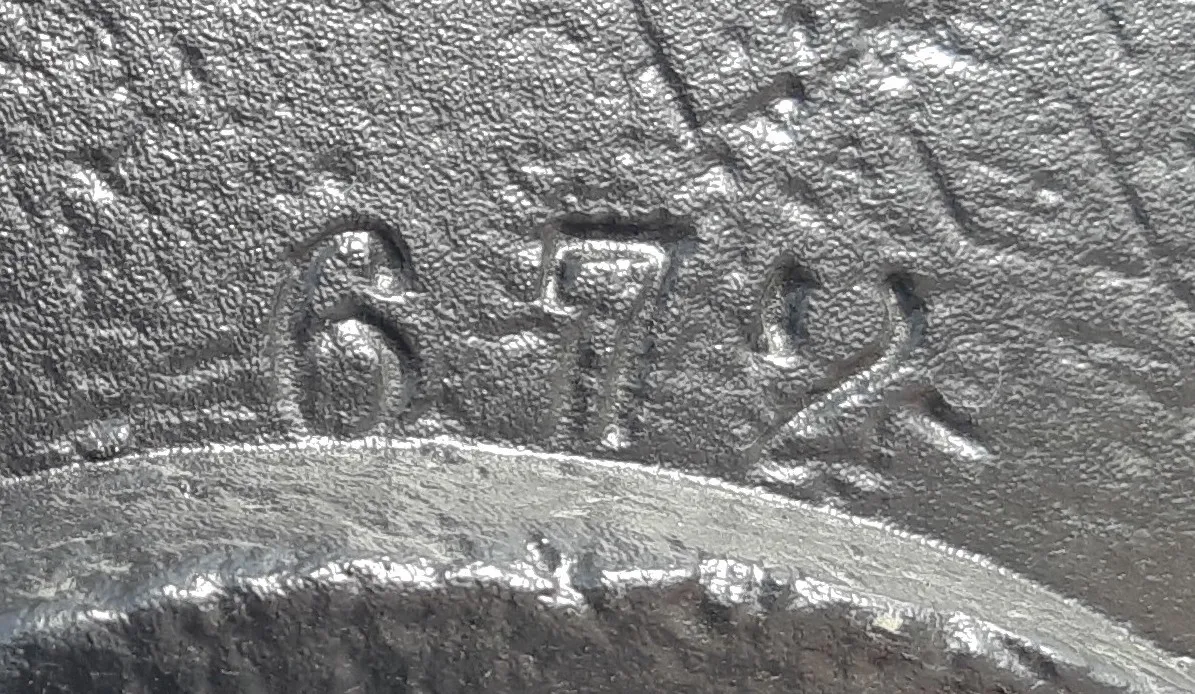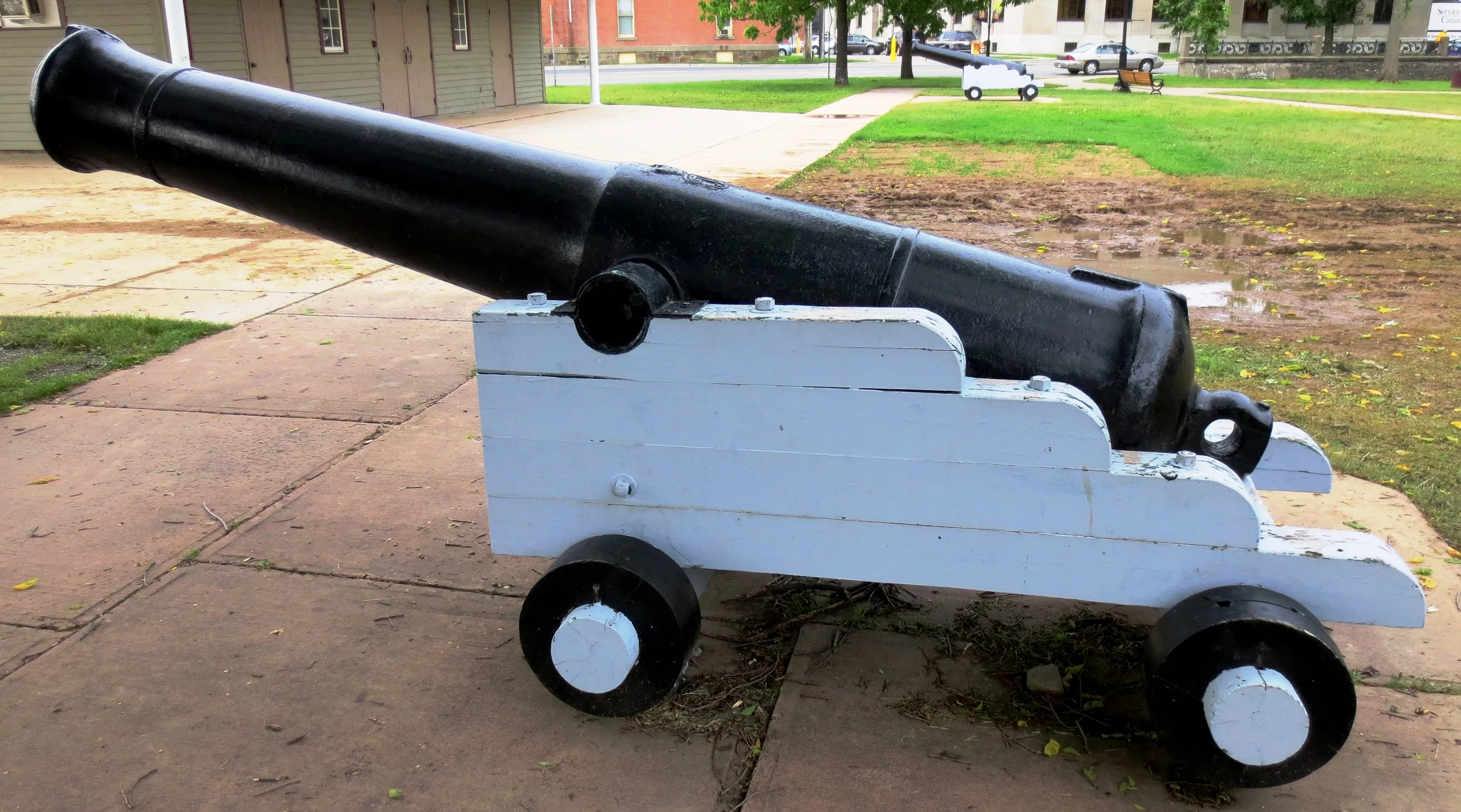Artillery in Canada: 64-pounder 71-cwt Muzzleloading Rifles, York Sunbury Historical Society, Fredericton Region Museum
Fredericton Region Museum, Officer's Square
The City of Fredericton, New Brunswick has returned the two cannon that have stood on Officers Square in front of the Fredericton Region Museum since 1947. They had been sand-blasted and repainted in the city's workshop on the north side of the river. This made it possible to read the serial numbers and weight information that had been nearly invisible under many previous coats of paint!
Cast Iron 64-pounder 71-cwt Muzzleloading Rifle (MLR) with a Dundas or Millar pattern breeching ring, Palliser conversion from a 32-pounder 58-cwt smoothbore muzzle-loading (SBML) Gun to a rifled muzzle-loading (RML) 64-pounder Gun, Queen Victoria cypher, broad arrow, Royal Gun Factory (RGF), (Serial No. 672) with an I, over a corroded possible 1856 on the left trunnion, blank on the right trunnion, weight 59-0 (6,608 lbs). RGF IRON on the muzzle. No. 1 of 2 that stands in Officer’s Square, North of the lighthouse on the Saint John River, opposite the York-Sunbury historical Society, Fredericton Region Museum. This gun came from Halifax ca. 1947. It has been cleaned and repainted for preservation with the City of Fredericton Operations Department.
Cast Iron 64-pounder 71-cwt Muzzleloading Rifle (MLR) with a Dundas or Millar pattern breeching ring, Palliser conversion from a 32-pounder 58-cwt smoothbore muzzle-loading (SBML) Gun to a rifled muzzle-loading (RML) 64-pounder Gun, Queen Victoria cypher, broad arrow, Royal Gun Factory (RGF), (Serial No. 308) with an I, over a corroded possible 1856 on the left trunnion, blank on the right trunnion, weight 58-0 (6,596 lbs). RGF IRON on the muzzle. No. 2 of 2 that stands in Officer’s Square, North of the lighthouse on the Saint John River, opposite the York-Sunbury historical Society, Fredericton Region Museum. This gun came from Halifax ca. 1947. It has been sanded and repainted for preservation with the City of Fredericton Operations Department.
These MLRs were brought from Halifax to Fredericton and placed on concrete foundations in front of the Area Headquarters Officers Mess that originally stood on Woodstock Road about 1947 through the efforts of Major A. Moulton Libby, a former Ordinance Officer at Saint John. After closing out the Area Headquarters, it was suggested by Lieutant-General E. W. Sansom, CB, DSO, O, St J, ED (Ret’d) that the guns be brought to Officers Square. This was acted upon by Colonel Alden R. Clark, Honorary Colonel of the 1st RNBR.
.webp)
(Author Photo)
The cannon return, mounted on new gun carriages, 5 May 2025. This is a cast iron 64-pounder 71-cwt Muzzleloading Rifle (MLR) with a Dundas or Millar pattern breeching ring, Palliser conversion from a 32-pounder 58-cwt smoothbore muzzle-loading (SBML) Gun to a rifled muzzle-loading (RML) 32-pounder Gun, Queen Victoria cypher, broad arrow, Royal Gun Factory (RGF), (Serial No. 308) with an I, over a corroded 1856 on the left trunnion, blank on the right trunnion, weight 58-0 (6,596 lbs). RGF IRON on the muzzle. It has moved to the No. 1 position of 2.
.webp)
.webp)
(Author Photos)

(Author Photo)
Cast Iron 64-pounder 71-cwt Muzzleloading Rifle (MLR) with a Dundas or Millar pattern breeching ring, Palliser conversion from a 32-pounder 58-cwt smoothbore muzzle-loading (SBML) Gun to a rifled muzzle-loading (RML) 64-pounder Gun, Queen Victoria cypher, broad arrow, Royal Gun Factory (RGF), (Serial No. 308) with an I, over possibly a corroded 1856 on the left trunnion, blank on the right trunnion, weight 58-0 (6,596 lbs). RGF IRON on the muzzle. No. 2 of 2 that stands in Officer’s Square, facing the lighthouse on the Saint John River, opposite the York-Sunbury historical Society, Fredericton Region Museum. This gun came from Halifax ca. 1947. It has been sanded and repainted for preservation with the City of Fredericton Operations Department.


(Author Photo)
Cast Iron 64-pounder 71-cwt Muzzleloading Rifle (MLR) with a Dundas or Millar pattern breeching ring, Palliser conversion from a 32-pounder 58-cwt smoothbore muzzle-loading (SBML) Gun to a rifled muzzle-loading (RML) 64-pounder Gun, Queen Victoria cypher, broad arrow, Royal Gun Factory (RGF), (Serial No. 672) with an I ,over possibly a corroded 1856 on the left trunnion, blank on the right trunnion, weight 59-0 (6,608 lbs). RGF IRON on the muzzle. No. 1 of 2 that stands in Officer’s Square, facing the lighthouse on the Saint John River, opposite the York-Sunbury historical Society, Fredericton Region Museum. This gun came from Halifax ca. 1947. It has been sanded and repainted for preservation with the City of Fredericton Operations Department.
.avif)
(Author Photos)
Fredericton Region Museum’s two Palliser conversion 64-pounder Muzzleloading Rifles
The cast-iron 32-pounder smoothbore muzzleloading (SBML) gun was the standard broadside gun on ships of the line of Royal Navy battleships in the 18th and 19th century. The most common of these guns found in Canada are the weapons designed by Thomas Blomefield in the late 1780s or 1790s. Made by Walker & Company of Rotherham, Yorkshire, England, and Carron of Falkirk, Scotland, these were excellent guns. The development of armour-plated steamships, however, meant that there was a need for heavier, longer-ranging weapons to be mounted in shore batteries and on warships. Lieutenant-Colonel William Dundas, who was Britain’s Inspector of Artillery from 1839 to 1852, designed two new 32-pounders which were part of the new armament accepted into Britain’s naval service.
When Britain adopted rifled ordnance in the 1860s it still had large stocks of serviceable but now obsolete smoothbore guns. Gun barrels were expensive to manufacture, so the best and most recent models were selected for conversion to rifled guns, for use as second-line ordnance, using a technique designed by Major William Palliser. The Palliser conversion was based on what was accepted as a sound principle that the strongest material in the barrel construction should be innermost, and hence a new tube of stronger wrought iron was inserted in the old cast iron barrel, rather than attempting to reinforce the old barrel from the outside.
This gun was based on the cast-iron barrel of the Millar Pattern 8-inch 65 cwt gun, originally designed in 1834. This gun was designed to fire a smooth bore spherical shell weighing 50 pounds. The 8-inch gun was bored out to 10.5 inches and a new built-up wrought iron inner tube with an inner diameter of 6.29 inches was inserted and fastened in place. The gun was then rifled with 3 grooves, with a uniform twist of 1 turn in 40 calibres (i.e. 1 turn in 252 inches), and proof fired. The proof firing also served to expand the new tube slightly and ensure a tight fit in the old iron tube.
These rifled guns were initially issued for Sea Service (SS), but by 1886 were obsolete in that role and were being returned to store for re-issue for Land Service (LS). In Naval service they were deployed on many smaller British cruising warships around the world.
In Land service many were mounted for coast defence in both British and colonial locations. They were mounted on a wide variety of iron and wooden carriages. They became obsolete for coast artillery use in 1902, whereupon most of them were scrapped and disposed of.
A Cast Iron 64-pounder 71-cwt Muzzleloading Rifle (MLR) with a Dundas or Millar pattern breeching ring, Palliser conversion from a 32-pounder 58-cwt SBML, weighed over 6,400lbs. Most had been cast as 32-pounders between 1853 and 1856. The Palliser modification with the guns being re-bored to 64-pounder, took place between 1868 and 1871.
.avif)
.avif)
.avif)
.avif)



(Author Photos)
Cast Iron 64-pounder 71-cwt Muzzleloading Rifle (MLR) with a Dundas or Millar pattern breeching ring, Palliser conversion from a 32-pounder 58-cwt smoothbore muzzle-loading (SBML) Gun to a rifled muzzle-loading (RML) 64-pounder Gun, Queen Victoria cypher, broad arrow, Royal Gun Factory (RGF), (Serial No. 672) with an I, over a corroded 1856 on the left trunnion, blank on the right trunnion, weight 59-0 (6,608 lbs). RGF IRON on the muzzle. No. 1 of 2.
.avif)
.avif)



(Author Photos)
Cast Iron 64-pounder 71-cwt Muzzleloading Rifle (MLR) with a Dundas or Millar pattern breeching ring, Palliser conversion from a 32-pounder 58-cwt smoothbore muzzle-loading (SBML) Gun to a rifled muzzle-loading (RML) 64-pounder Gun, Queen Victoria cypher, broad arrow, Royal Gun Factory (RGF), (Serial No. 308) with an I, over a corroded 1856 on the left trunnion, blank on the right trunnion, weight 58-0 (6,596 lbs). RGF IRON on the muzzle. No. 2 of 2.


(Johan W Brunings Photos)
Typical bronze gunsite used on Muzzleloading guns of the period.
.webp)
(Author Photo)
The gun carriage is built to scale with Eastern White Hemlock, the wheels are made from pipe and welded to specification in Fredericton.
.webp)
The author is very pleased to see them being put back on display in Officer's Square.





